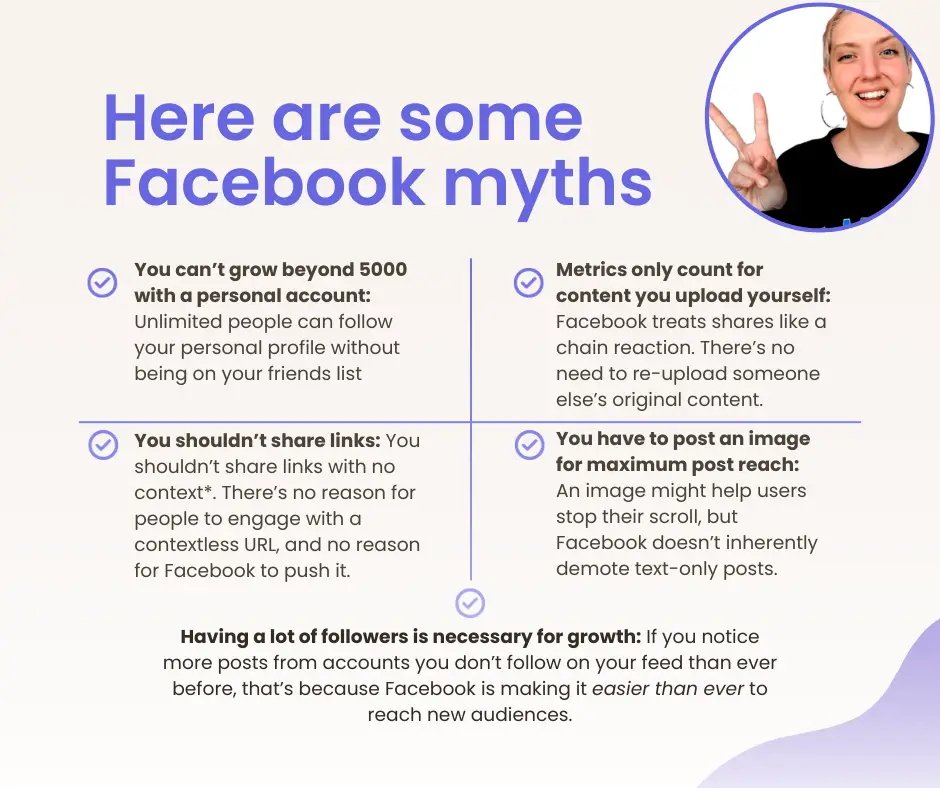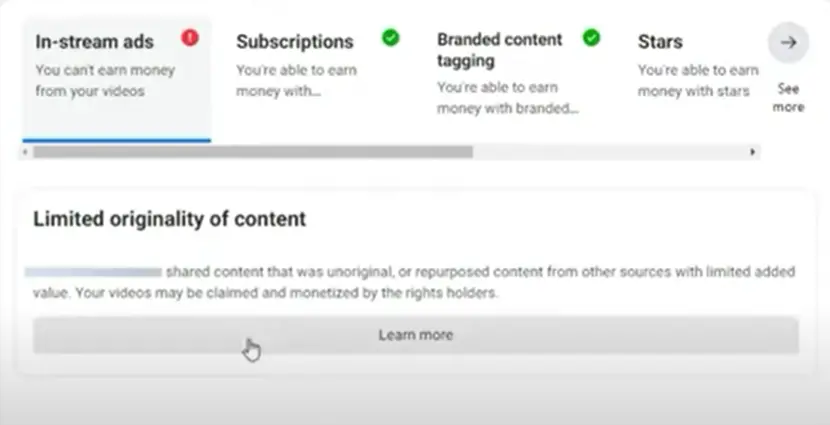The Facebook growth strategies working right now are not the same as what worked yesterday. Here are some myths you need to dispel for better growth and tips on what to do instead.
Table of Contents

Myth 1: There’s no Facebook fan growth for personal pages
Just like Facebook pages, personal profiles can accumulate unlimited followers (and they don’t need to take up space on your 5000-capped friends list. People who follow your personal page will be called followers instead of fans.
What this means: You don’t need to create a separate page just for Facebook fan growth; you can gain followers as a personal page! There are pros and cons to using either type of account, but growth is nevertheless completely possible with either.
Pro-Tip for growth on personal Facebook profiles: If you opt-in for your personal profile to become a “digital creator” profile, you can unlock the same “invite” button Facebook pages have to invite people who like your posts to follow your profile (a minimum of 500 followers is required for personal profiles to start using this feature).
Myth 2: Facebook growth depends on the content you upload yourself:
One of the best tips for growth in 2023 is to embrace sharing content from others instead of downloading it and re-uploading it. Facebook has evolved to attribute engagement metrics to more than just the original uploader. In other words, Facebook shares are like a chain reaction, and it’s possible to grow a page through direct content shares exclusively (I’ve done it!). There’s no need to re-upload someone else’s original content.
Re-uploading someone else’s content can kill your growth in the long run if it triggers duplicate content restrictions on distribution and reach (source: Limited Originality of Content Guidelines | Meta Business Help Center)
Facebook is getting better at detecting when someone uploads someone else’s original content without adding enhancements to it. They’ve been able to detect duplicate uploads through videos and audio for a while:

But they are also starting to detect and flag duplicate image uploads. They’ve even broadened the language in their policy:
You should know that restrictions for unoriginal content usually aren’t placed immediately – people are reportedly getting notices of such restrictions years after posting something.
What this means:
- You should never steal someone’s content and present it as your own
- You should embrace sharing content you enjoy – nobody is going to mind that you’re sharing. Curating is just as valuable to platform experience as creation, and you can gain impressions and engagements from your shares.
- If you are going to use someone else’s original content and upload it yourself, it should be transformative in some way. This might mean you added commentary to a video clip or insights to a screenshot of a picture you grabbed from somewhere else.
As always, be mindful of copyright and licensing limitations when republishing content, especially if the post is monetized through the Facebook Bonus program or any other channel.
Myth 3: Facebook won’t distribute your post if you put a link in the caption:
This is false. Many of my posts that perform above average include links to off-platform content.
What’s true: If you share a post that happens to have a link, and the initial sample of people Facebook shows it to do not engage with it, Facebook isn’t going to give that post stellar distribution. But, this is true for any type of post on Facebook, link or not.
Indeed, it’s not a good strategy to share a link and nothing else – the Facebook algorithm needs context to know who to put your post in front of. Users will appreciate this context, too.
What this means: What matters is whether or not the people who see your content want to stop and give it attention and engagement. If your post is just a link without any compelling context, it just looks like empty self-promotion. You are asking the user to do more work (i.e. leave Facebook to do something), without a compelling and relevant reason why.
If a user doesn’t want to click your link and there’s nothing else for them to expand save or comment on about your post, they will keep scrolling without any trace of engagement. Facebook will then interpret this as the user not paying attention to your post, and this could reduce the likelihood Facebook will continue to distribute your post.
So, how can you use external links to connect your Facebook followers to content on other platforms? Lead with content that’s valuable in and of itself. In other words, give them more value than just a link for people to figure out themselves.
I’m writing a full guide with real-world examples of specific steps to do this. Make sure you follow me somewhere on social (my Facebook, my Linkedin) to see when it’s published.
Myth 4: You have to post an image for maximum post reach:
An image might help users stop their scroll, but Facebook doesn’t inherently demote text-only posts.
To best understand why there’s a correlation between posts with images and higher reach, it’s worth understanding what makes Facebook increase post discoverability.
- When you make a new post, Facebook will first show it to a smaller cross-section of people. These people could be your direct connections (i.e. friends and followers) and/or users identified as having a high interest in the topic(s) discussed in your post.
- If this small sample responds well to your post (they stop scrolling and watch, bookmark, like, or comment), Facebook will push it out to a larger sample size.
- If you are posting consistently and your posts usually get engagements, Facebook may give you increased visibility on anything you post, as soon as you post it, for a short period. You will get a notification from Facebook saying you have increased visibility.
What this means is that if your image draws someone in to pay attention to a post they would have otherwise scrolled past, the image has aided in increasing your reach. But, the same thing happens when the first line of your post captures attention (and it’s why writing effective social post hooks is more important than ever)
Myth 5: Early follower growth is really hard
If you notice more posts on your feed from accounts you don’t follow, that’s because Facebook is making it easier for for to reach new audiences than ever before. You can take advantage of this, even for early follower growth as a new account.
Why Facebook does this: if content keeps you on the platform, it doesn’t matter if you follow the account that posted it or not. Facebook’s goal is to play Matchmaker between users and content to increase daily average users and time on the site/mobile application.
How to increase your reach without a huge following: You probably still want to grow your Facebook audience, right? There are two things you must do to reach new people and turn that reach into new followers. Here are some quick tips for both:
- Increasing discoverability and reach
If you want Facebook to show your content to people who don’t already follow you, Facebook needs to understand what your content is about so they can put it in front of who they think would be interested in it. Here are things you can do to optimize for content-based affinity matching.
- Explain what your post is about in the captions. Use keywords that describe the topic of your content.
- Use relevant hashtags
- For Reels videos, add keywords to on-screen text during upload
- For images, check the alt text and make sure it is descriptive
- Tag relevant people and accounts when your content is about or involves them.
Outside of helping the algorithm understand your post, you might also consider sharing your post with relevant Facebook groups.
- Getting new users you reach to follow you on Facebook:
Getting your content in front of more people is only half the battle. You also want to get people who are interested in your content to follow you for more. A follow will increase the likelihood that user will see more content from you in their Facebook feed.
Here are the best practices for getting more Facebook followers from the content you post:
- Post good, original content. If people like content and don’t think they can get it from a million other accounts, that’s a huge reason to follow you.
- Use the invite button to invite people who like your content to follow you. If you’re eligible to use this feature, you can find it by clicking on your posts likes. There will be an “invite” button next to someone’s name, where an “add friend” button would usually show. Any page can do this, as well as any profile with over 500 followers (not friends, but followers).
- Leverage CTAs in your post to win follows. Remind people in the post caption, post media, and/or post comments to follow you for more content. You can dress up the CTA however you like.
Facebook growth strategies change and evolve often, but good, authentic content will always shine. Put the tips from this article into practice, embrace direct shares of content from other pages, and keep it social. You can also follow me on Facebook to see bite-size tips, memes, and conversations that don’t exist anywhere else. Cheers!


